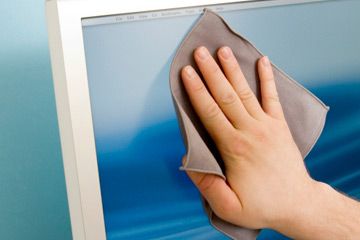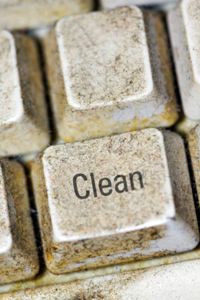Key Takeaways
- To clean a flat-screen TV, first turn it off and unplug it along with any connected devices. Then use a mix of water and a teaspoon of isopropyl alcohol for cleaning.
- Apply the cleaning solution by lightly dampening a lint-free or microfiber cloth, not by spraying directly onto the screen, to avoid damaging the screen's special materials or coatings.
- Avoid using regular glass cleaners or household products that contain ammonia, as these can strip anti-glare coatings and damage the screen. Instead, refer to the owner's manual for model-specific care instructions.
Liquid-crystal display. Plasma technology. LED-backlighting. While these cutting-edge features help to create the ultimate viewing experience, they can also lead to confusion over the best way to clean your new flat-screen TV. Unlike older cathode-ray sets -- which feature solid glass screens -- modern flat-screens often include special materials or coatings that can be damaged by traditional cleaning products. Now that you've updated your TV, it's time to switch to flat-screen friendly cleaning techniques that can safely eliminate dust, dirt and grime.
Before you begin, be sure to turn off your set and unplug it from the wall. Don't forget to unplug any auxiliary devices, like DVD players and cable boxes. Leave these items unplugged until you finish cleaning and the screen is completely dry to minimize your risk of injury or property damage.
Advertisement
While you'll find countless cleaning kits and specialty products marketed towards the flat-screen owner, most experts recommend using good old-fashioned water to clean your screen without damage. If your TV tends to collect lots of fingerprints, add about a teaspoon of isopropyl alcohol to a bowl of water to create your own homemade screen cleaner. Most rubbing alcohol is made from isopropyl alcohol, but always check the bottle before using this product to clean your TV. Some kinds of rubbing alcohol are actually made from ether alcohol, or ethanol, which isn't the best choice for flat-screen televisions.
Whether you're using an isopropyl alcohol blend or just plain water, keep in mind that you should never spray these materials directly onto the screen. Instead, dip a lint-free or microfiber cloth into your cleaning solution of choice, then wring it out until it's just slightly damp. Many newer TVs come with an appropriate cleaning cloth, so check the box before you buy. You can also use a cloth designed for cleaning eyeglasses or camera lenses, as they're made to clean without leaving lint or scratches behind. Wipe the screen very gently in smooth, even strokes to remove dust and other contaminants. Don't apply excess pressure or scrub at your screen, as this could seriously damage your picture, and can even lead to dead or burnt-out pixels. When you've finished cleaning, carefully dry the screen using a soft, lint-free cloth. Never use a dirty cleaning cloth, as even tiny particles of dirt may become trapped in the fabric and can scratch your screen. While you may be tempted to use a clean paper towel, wood-based paper products are just too harsh for delicate flat-screens, and can leave behind ugly scratches that interfere with your viewing experience.
Finally, don't make the mistake of using regular glass cleaner or other household cleaning products on a flat-screen TV. Ammonia and other chemicals used in these products can strip anti-glare coatings from the screen or leave behind other serious signs of damage. When in doubt, refer to the owner's manual that came with your TV to determine the dos and don'ts for your particular model.
Advertisement


